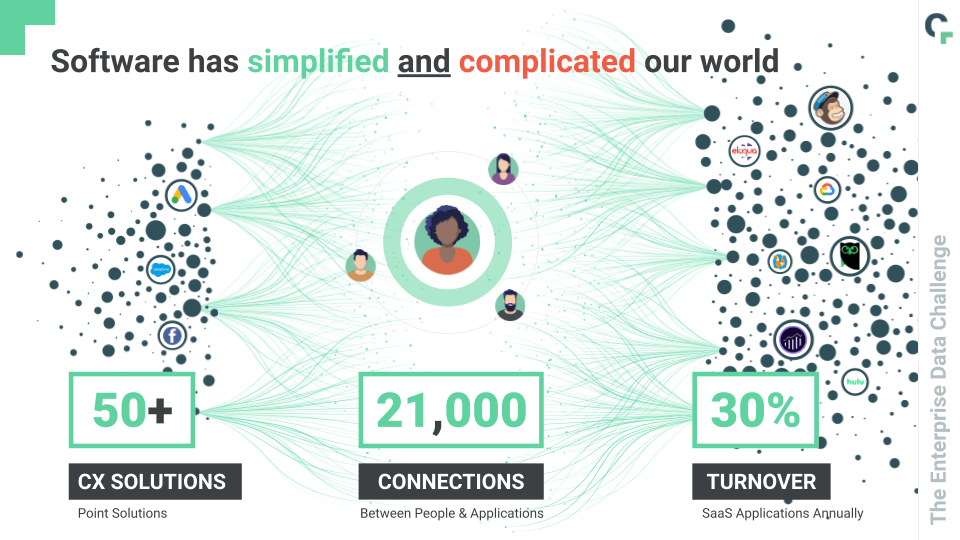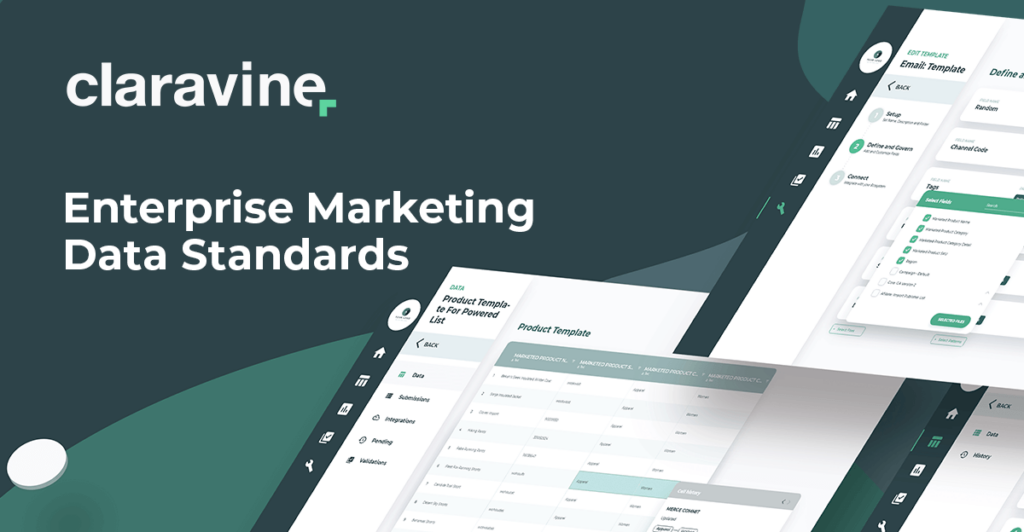What’s Causing Your Data Silos & How to Fix Them

Data silos (sometimes lumped in as “information silos”) and similar silos of communication and collaboration tools are costing your organization dearly. They degrade not only your organization’s data quality, but its cornerstone of strategy, too: data integrity.
Trying to rely on data stuck in silos prevents collaboration, hinders access to data for business intelligence, and obscures the view of your customers’ experience — to name only a few of the risks.
The shift to first-party data collection and data sprawl has only compounded their impact as more and more data becomes effectively inaccessible across the organization.
Consequently, addressing data silos and the behavior that leads to them is mission-critical for organizations to be data-driven and competitive.
To deconstruct your data silos and rebuild them as cohesive, standardized, cooperative data bridges with infallible structural integrity, you should be asking the following questions:
Table of Contents
What Are Data Silos?
Data silos, or information silos, are compartmentalized repositories of data that don’t link to the other applications within your IT infrastructure, nor between any team other than the originator.
The root of data silos comes from traditional organizational structures in which each department created, managed, and analyzed its own data. With narrower fields of data creation available, the intersection of usefulness — let alone efficient sharing — between teams rarely arose.
For example, early customer relationship management (CRM) solutions were like online Rolodexes for sales reps to track prospects, customers, and call notes. However, they were standalone systems that didn’t link to the customer data platforms (CDPs) marketing and customer/tech support used.
This meant sales reps didn’t have a complete view of their customers and couldn’t tailor their interactions accordingly. To obtain information outside of their “Rolodex” they had to make phone calls or send emails to the relevant departments in a relatively unstructured manner.

Such organizational silos were the norm until the explosion of big data, the cloud, and other technology advances fueled data-driven initiatives and collaboration across business lines. Today sales reps can have a complete view of the customer along with access to sales support materials through enterprise marketing taxonomy.
What Causes Data Silos?
Though data silos are commonly found in traditional organization structures, they proliferate due to technology, growth, and culture. They’ve become endemic in the age of data sprawl.
Legacy (Aging) IT Infrastructure
Legacy systems aren’t known for their flexibility or interoperability with other systems. And when systems can’t “talk to each other,” it’s impossible to share information across an organization. Relying on these standalone systems without addressing their lack of connectivity with other systems will inevitably result in data silos.
Decentralized Technology and Tool Management
When business units are allowed to evaluate and purchase their own tools, it can result in data silos or the deployment of technology that’s incompatible with other systems. Look below the hood, at the data that’s being created, collected, and organized? Not an ounce of standardization in sight. Hence, the siloing of data.
Mergers and Aquisitions
As a company grows through mergers and acquisitions, it acquires new systems and data stores. Unless both are properly integrated and support information sharing, they’ll struggle with data silos even on the same team.
Rogue End Users
A data silo can be as simple as an Excel spreadsheet that users update and maintain on their workstations to fulfill their job tasks. This can impact reporting accuracy and insights if their data doesn’t align with similar datasets stored elsewhere.
Company Culture and Organizational Silos
Even as an organization streamlines operations and democratizes data, deep-seated company culture can continue to fuel data silos. Departments that are used to independently managing their processes, business goals, and challenges may resist the idea of sharing information.
Why are Data Silos Problematic and Costly for Your Business?
While business and customer confidentiality would of course require a siloing of data, the overall presence of data silos is working against your entire organization. There’s no logical argument against eliminating data silos. Rather, shifting silos to standards will better serve any data confidentiality or quarantine needs while improving collaboration and usability for everyone.
Here are eight problems you’ll solve as you embark on your de-siloing crusade.
1. Fragmented Views of Business Units
Data-driven businesses can make million-dollar decisions on a dime. Data-siloed businesses lack that agility. That’s because they can’t stitch a seamless, cohesive picture of their organization — using that word crucially as an organized group that functions together at a level higher than its mere sum.
While leaders can request data from multiple data stewards to obtain a more holistic view, it won’t have the context or connections with other relevant data to inform sound, strategic decisions. It’s the difference between data-driven and data-bloated.
2. Data Analysis That Operates Well Below its Potential
Data silos may store information differently, which presents a challenge if you perform business analytics. Inconsistent or poorly formatted data will have to be standardized and transformed before it can provide useful insights and value to your organization.
That means siloed data either won’t get used or it won’t get used until later, when it’s much less useful.
3. Teams That Can’t Collaborate and Amplify
When teams only have access to their specific data it can lead to a “stay out of my sandbox” mentality and a hyperfocus on individual objectives. When different datasets, tools, and people are all unfamiliar and inconsistent, tensions rise when cross-functional opportunities surface.
Without collaboration and the free flow of information, achieving enterprise-level goals or a shared vision is nearly impossible.
4. Productivity Plateaus
Leaving data isolated within individual teams and departments kills productivity. Users that require data outside their purview must first determine which team owns the data, then request and obtain access, and before they can finally analyze it for their purpose. Searchability, let alone discoverability, are not hallmarks of data between silos.
So by the time someone has completed those steps, the data may no longer be valid, and they’ll have to start the process again. Data silos also hurt productivity through duplicative efforts that result from a lack of task coordination and information sharing.
5. Wasteful, Inefficient Data Storage
There’s usually a degree of overlap regarding the data users need to do their jobs. And if every person who uses the same dataset stores the information in their data silo, it wastes storage space.
In addition, siloed environments require more technology and human resources (i.e., specialized tools, data stewards, and data analysts) than a centrally managed enterprise data warehouse or data lake with proper organization
6. Security and Compliance Risks
Organizations with siloed, fragmented data can’t establish comprehensive, effective data governance that protects against cyber threats, data breaches, and the running afoul of data privacy regulations.
Silos also threaten hindsight forensics on these events, limiting the organization’s ability to find the team, workflow, tool, or other element responsible for the failure.
7. Suboptimal Customer Experiences
A scattered customer experience doesn’t make for a happy customer — nor does it make it easy for analysts and effectiveness leaders to draw reliable insights from journey data. Your customers have multiple touchpoints with your business during the buyer journey. They might include website and social visits; marketing and sales communications; VOIP or traditional phone calls; chats with support and billing; and more.
When all of this information is stored in different silos, it presents significant challenges — especially for marketing operations. In fact, 47% of marketers consider data silos the main reason they don’t have an accurate view of the customer journey. Of course, this makes it impossible to provide an excellent customer experience.
8. Inadequate Data Integrity (Unstable Data Foundation)
Because data silos are essentially stores of fragmented data, establishing enterprise data governance is impossible. And without guiding principles, individual business units design their own data and metadata management methods (if they do so at all).
Plus, individual users may be free to create micro-data silos within Google Drive, Microsoft Excel, and their desktop and mobile devices.
Neither scenario offers any assurance that data is accurate, consistent, or trustworthy.
How Can Data Silos be Eliminated and Replaced?
Change isn’t easy, but it’s necessary to remain competitive as technology and business processes evolve. Fixing data silos is essential, too, and it begins with addressing silo mentality in your organization. Team members must understand that choosing not to share information or collaborate with others comes at a tremendous cost.
Here’s how to tear down data silos and rebuild a data ecosystem with integrity.
Implement Metadata Management and Data Governance
It’s essential to establish an enterprise metadata management and data governance program before you start removing data silos. Then you won’t have to worry about new silos developing, since data management will be aligned with your business goals and team members will have common standards and policies to follow.
Integrate and Centralize (All of the) Data
Various data integration techniques can break up silos allowing you to centralize data into a cloud-based data warehouse, onsite repository, or data center to support taxonomies and business analytics. Here are the typical methods.
- Scripting: Tasking IT professionals to write scripts using SQL or other languages will move data safely to the target application.
- ETL tools: Extract, transform, and load tools automate data transfer from various data sources to your repository while converting them into a standard format for later analysis.
- Integration Platforms as a Service (iPaaS): Cloud-based integration software links your existing applications and data flows with options for one-way data pushes, two-way data sync, as well as enterprise solutions.
Modernize Your Analytics Tools
Eliminating silos and silo mentality should extend to building your technology toolkit. It’s critical to evaluate and select analytics tools the entire organization can leverage rather than tools for individual business units.
After all, the whole point of consolidating data is to establish a single source of truth and one point of access for business intelligence and data-driven decision-making.
Ingrain Collaboration and Integrity into Company Culture
A recent study found 86% of leaders consider lack of collaboration as the top reason for workplace failures. But unless you address data silos and the behavior that contributes to them, collaborative work environments will remain out of reach.
Promoting a more collaborative culture starts with leadership that establishes data as the key to the organization’s future success. Clearly communicating the problems with information silos versus the benefits of data sharing plus regular training will promote employee buy-in.
What’s Stopping You? (Data Integrity is Within Reach)
As you daydream of your data silos reduced to rubble, the next consideration is rebuilding a modern data stack. Any initiative must ground in data integrity, hence the enterprise-permeating benefit of a data integrity solution connecting your teams and tech stack, top to bottom and around the globe.











